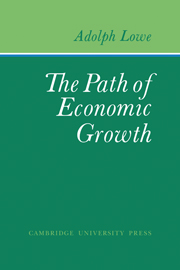Book contents
- Frontmatter
- Contents
- Preface
- Acknowledgments
- PART I The Basic Model
- PART II Changes in the Rate of Change
- 11 The Setting of the Problem
- 12 A Bird's-Eye View of an Expanding Traverse
- 13 On the Short-Period Variability of the Capital–Labor Ratio
- 14 Adjustment to a Higher Rate of Growth of Labor Supply in a Free Market. I. Structure Analysis
- 15 Adjustment to a Higher Rate of Growth of Labor Supply in a Free Market. II. Force Analysis
- 16 Adjustment to a Higher Rate of Growth of Labor Supply in a Collectivist System
- 17 Some Comments on the Role of Working Capital in the Traverse
- 18 Instrumental Analysis of Decline in the Rate of Growth of Labor Supply
- PART III Changes in the Rate of Change
- PART IV Changes in the Rate of Change
- Appendix: An Alternative Presentation of Lowe's Basic Model
- Glossary of Recurring Symbols
- Name Index
- Subject Index
11 - The Setting of the Problem
Published online by Cambridge University Press: 07 October 2011
- Frontmatter
- Contents
- Preface
- Acknowledgments
- PART I The Basic Model
- PART II Changes in the Rate of Change
- 11 The Setting of the Problem
- 12 A Bird's-Eye View of an Expanding Traverse
- 13 On the Short-Period Variability of the Capital–Labor Ratio
- 14 Adjustment to a Higher Rate of Growth of Labor Supply in a Free Market. I. Structure Analysis
- 15 Adjustment to a Higher Rate of Growth of Labor Supply in a Free Market. II. Force Analysis
- 16 Adjustment to a Higher Rate of Growth of Labor Supply in a Collectivist System
- 17 Some Comments on the Role of Working Capital in the Traverse
- 18 Instrumental Analysis of Decline in the Rate of Growth of Labor Supply
- PART III Changes in the Rate of Change
- PART IV Changes in the Rate of Change
- Appendix: An Alternative Presentation of Lowe's Basic Model
- Glossary of Recurring Symbols
- Name Index
- Subject Index
Summary
We have finally reached the foot of the mountain. The structural and motorial analyses pursued in Part I have served the purpose of tooling up. The analytical instruments previously elaborated are now to help us in investigating a selected group of problems which can all be subsumed under the general heading of “changes in the rate of change.” More precisely, we shall be concerned with the “traverses” that lead, under the impact of a change in the rate of increase or decrease of one of the basic resource factors (labor, natural resources, technology), from an initial dynamic equilibrium to a terminal dynamic equilibrium at a higher or lower rate of resource utilization.
Part II deals with the traverses as engendered by changes in the rate of change in labor supply, whereas Part III takes up the question of diminishing returns of natural resources and, in addition, the technique of recycling residuals. Part IV studies some of the processes by which changes in the rate of productivity can be absorbed.
Two decades ago I discussed some of these problems in the framework of stationary rather than dynamic equilibrium. For didactic purposes we shall occasionally take our bearings from this simpler frame of reference. However, it stands to reason that analysis within a dynamic framework not only presents a more general case from which the stationary adjustment processes can be derived by setting the initial and the terminal rates of growth equal to zero, but it has also greater empirical relevance.
- Type
- Chapter
- Information
- The Path of Economic Growth , pp. 103 - 108Publisher: Cambridge University PressPrint publication year: 1976



